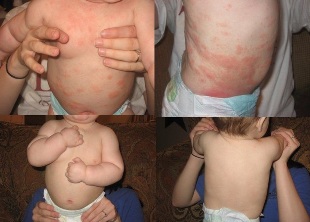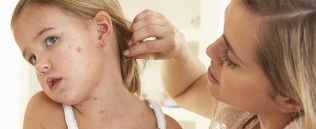The psoriasis in children diagnosed at any age. It is a chronic disease that can also affect children and infants, in recent years, the cases of children psoriasis young children of preschool age. When the first signs of the disease, it is necessary to begin a complete treatment. Before he can reach the state of stable remission; it is better for the health of the child.

The causes of the appearance of psoriasis in child
Children the psoriasis has a systemic nature. Its development lead to disorders in the functioning of the immune system when the body can not resist the harmful effects of external factors.
The doctors can't highlight a cause that results in the appearance of the child's illness. But there are a number of scientifically-based hypothesis:
- Hereditary predisposition – if they have been diagnosed cases of psoriasis, the likelihood of the development of a child increases by 30%. When from this illness suffer from both parents, it increases up to 80%. But inherit only a predisposition to the disease and, so, with the right care for the child there is the possibility to avoid it.
- Disorders of the nervous system – the negative experiences, stress, life changes (change of school, the birth of a second child) can lead to the appearance of the disease.
- Violations of the metabolic processes – the lack of vitamins, trace elements.
- The presence of parasites helminths absorb the useful substances, emit large quantities of toxins, which adversely affects the child's body. Often appear in skin reactions, and psoriasis.
- The infection in childhood psoriasis often appears after the transfer of infectious diseases. Can cause sore throat, flu, colds.
- The dysfunction of the endocrine system – hormonal imbalance causes the psoriasis.
- Diseases of the liver – in the case of irregularities in the functioning of this organ that the body cannot neutralize the toxins, which can lead to the development of psoriasis. Often the psoriasis in children for the first time, is diagnosed during the cold season. Significantly increases the risk of development, and lesions of the skin.
The symptoms of psoriasis in children

The signs of psoriasis the breast-fed baby is significantly different from the symptoms of this disease in the adult. The children in the initial phase appear red precipitation in the folds of the skin (in the gluteal region, axilla), on the head, face, genitals. She is located in areas subjected to continuous rubbing of the clothes. Rarely, the rash occurs on the palms of the hands and feet. The eruption reminds intertrigo, but she is the main symptom of psoriasis – horny ball papules exfoliate, appears flaking. Gradually the delicate skin is covered by a layer of scales-crusts. Isolated small papules merge into conglomerates. Their size gradually increases, which cover large areas of the epidermis. In most cases, the rash will itch, bringing the child to the discomfort huge. Combing papules, and the risk of infection.
Childhood stage of psoriasis and their symptoms
- Progressive – the appearance of small red skin rash or bright pink color. She itches, flakes, increases in size and apply on the skin. Soon the eruption is covered with cracks, and begins to bleed a little. Unlike adults, in children is virtually absent, the phenomenon stearic spots, the terminal film. In case of severe form, progressive stage, the child increases the temperature of the body, compacted the surface of the epidermis, increasing the lymph nodes, it is observed oedema of the skin, redness.
- Freeze – the formation of new skin rashes, and their growth will stop, decreasing the intensity of the peeling.
- Regressive – rash begins to gradually dissolve. After his death on the skin appear депигментированные bands.
When it is completely disappearance of signs of disease comes into remission. Its duration depends on the characteristics of the childcare, in particular from the diet. The relapse of the disease in children is often the result of transfer of infectious diseases.
Types of psoriasis infantile
Distinguish different types of psoriasis in children. They are classified, regardless of the characteristics of the symptoms and localization of the rash. The main forms of the disease:
- Free psoriasis. Appears in children up to one year. Rashes localized predominantly in the area of the buttocks. Because of continuous contact with excrements and urine, in consequence of the rubbing cloth diapers skin in this area is irritated, so the disease difficult to diagnose. Parents often take this vent to the dermatitis, which prevents you from starting a timely treatment.
- The Tabula (normal) psoriasis. The most common form of the disease in children. Its characteristic symptoms on the surface of the skin to form patches of red color. The first are small, but quite fast increases in diameter, they begin to fall apart. The base of the papules has a thick consistency. Top are covered with a loose layer of scales, which are easily separable. Locate Tabula papules on different areas of the body, but most often occur in the area of the flexion of the elbows and also the knees, the scalp.
- The guttate psoriasis. The body is covered with a lot of skin rashes, which form an appearance, such as a drop, with the small size and the convex shape. Papules rise above the surface of the epidermis, cortices. They cover the head, the arms and the legs and the trunk. The rash can disappear or turn into a clean psoriasis. At the age of 4-5 years, this form of the disease caused infection streptococcal.
- Generativus pustular psoriasis. It develops quite suddenly and very fast. For a short period of time to large areas of inflamed skin, are covered by ulcer. Affected areas of epidermis hurt. This form of psoriasis is dangerous because it causes serious complications. It can lead to diseases of internal organs, particularly the kidneys, the heart.
- pustular psoriasis.Affects children over the age of 7 years. In infants and preschool children is rare. It is a severe form of the disease, which appears in swelling of the skin, and its surface is covered with bubbles filled non-communicable exudo. It is often accompanied by inflammation of the lymph nodes.
- Erythrodermic psoriasis. It is a form, provocaverunt praesent of the thermoregulation of the body. Manifests itself in generativus inflammation of the epidermis, intense шелушении. Accompanied by severe itching, painful feelings. The large square of the skin begin to flake off. Can be fatal, especially if the child is small.
- Psoriasis bending of the surfaces. Appears to be in decline in the body, most often in the internal area of the thigh, the groin, the genitals. The body covered with patches of red color. They are smooth and not cortices, but a little protruding.
- Arthropathic psoriasis. It affects the joints. The signs of this form of the disease – muscle stiffness, they cease to be mobile, and the joints and the fingers swell and swell. Knees, fingers, ankles, wrists hurt, there is a general feeling of discomfort. Can appear conjunctivitis. Based on the flow type of psoriasis is divided into types: winter or summer, regardless of the season, when there is a relapse, the majority of children of the winter form; for the first time emerged – when the symptoms appear for the first time; continually recurring – continuing worsening of disease; uncertain form.
- Psoriasis of the nails. Affects clavum plate. The symptoms depend on the form. Highlight the following varieties:
- naperstkovidnym – on the surface of the nails are formed of small depth, because of what they visually become similar to the thimble;
- nicomedes – nails peel from the bed very quickly;
- onycholysis – the nail gradually peel bed, with inflammatory processes is missing, around the base of the nail appears yellow background-pink colour;
- trachyonychia – nail thickened, coarse, and its surface becomes corrugated, raised edge;
- the hemorrhaging subungual – beneath the surface of the nail appear spots and streaks, red-pink;
- paronychia psoriatica – the skin around the nail, the same finger thicken, and is accompanied by intense inflammatory processes.
The diagnosis of psoriasis in child
The diagnosis of psoriasis made by a dermatologist. He performs a physical examination of the child, clarifies, when it appeared rash, how the disease manifests, if there are normally people who suffer from this disease. To establish the diagnosis children especially under the age of 1 year, only visual inspection is difficult, because they often lack the classic symptoms of the disease: stearic point, the terminal film and the "dew of blood". Exactly ensure, in the presence of psoriasis, it allows the analysis of a curettage, taken with a surface of a skin rash.
Treatment of psoriasis in children

Children, the sufferers of psoriasis, they need to complete treatment. Quickly reach a state of remission will help the therapy system, also aimed at the resolution of the symptoms and strengthen the body in general. Let's examine the main methods of treatment.
Medicines for external use
Effective for the resolution of the papules that affect the skin. To this group belong:
- salicylic ointment 1-2% - it is contraindicated for children infants to age;
- sulphur-tar ointment 2-3%; boric ointment;
- glucocorticoid ointment 0.5% – "Locacorten", "Flucinar", "Prednisone";
- inhibitors of phosphodiesterase – papaverine ointment 1%, and theophylline ointment 5% for the treatment of psoriasis, hit ochroleuca part of the head;
- steroid creams and ointments – "instruction on", "Haec solutio" and other ointments psoriasis;
- heparin ointment – for long-time of the platelets.
Medicines for internal use:
- desensitizing funds – three times per day proven to take a solution of calcium gluconate 5% to the tsp, the length determines the medical;
- sedative – children can be a tincture of valerian;
- antihistamine drugs to relieve the itching – 7-10 days of taking "Tavegil", "Suprastin", with acute conditions are introduced injection, when lighter – you can prescribe the pill;
- tranquilizers – in rare cases are assigned for older children, you can apply "Tazepam", "Седуксен";
- vitamins to strengthen the immune system – the ascorbic acid, B12, B15, D, E, F, drink three times a day for a couple of months;
- пирогенные drugs – to activate the body's defenses, normalization of vascular permeability, prescribed 8-10 injection "Пирогенала", children over the age of 3 years;
- glucocorticoids – are awarded in the most serious cases, the course of 2-3 weeks, with a gradual reduction of the dose.
A proper diet
For the quickest possible to treat psoriasis and achieve a state of remission, it is necessary to observe a proper diet:
- exclude from the diet, cakes, buns, sweets, fatty and fried meals, chocolate;
- limit consumption of citrus fruits;
- to drink enough liquids;
- replace sweet drinks herbal teas;
- the basis of the diet of vegetables, herbs, recenter fruit juices, diet of lean meat, fish.
Prevention

To minimize the risk of disease and prolong the period of remission, follow the simple rules:
- while swimming do not use aggressive media and harsh towels;
- teach your child to avoid cuts, burns, injuries of skin; to take care of a child from contact with the skin from the direct rays of the sun;
- give preference to clothes made from natural fabrics; follow the child's diet; gently collect the drugs.
- try to keep the child has dominated positive emotional state.
When you experience the slightest suspicion that the child appeared psoriasis, consult a dermatologist. It is a serious disease, so how to treat it can say only a competent physician. Do not self-medicate, prior to you go effective therapy, the faster we will be able to reach a state of support remission. Despite the fact that psoriasis is not treated properly and timely approach, it is possible to reduce the number of relapses of the disease.























